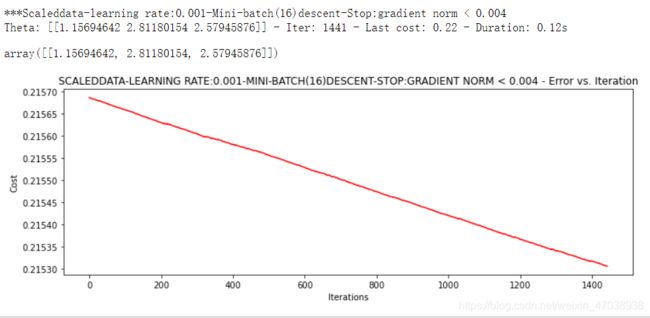5.回归算法-梯度下降求解逻辑回归代码调试
梯度下降求解逻辑回归
《跟着迪哥学Python数据分析与机器学习实战》
报错一
path = 'data' + os.sep + 'LogiReg_data.txt'
#os.sep在Windows上文件的路径分隔符是'\'在Linux上是'/'
#os.sep根据你所处的平台自动采用相应的分隔符号
修改
path=r'D:\software\Anaconda\JupyterNotebookCode\LogiReg_data.txt'
import pandas as pd
path=r'D:\software\Anaconda\JupyterNotebookCode\LogiReg_data.txt'
pdData=pd.read_csv(path,header=None,names=['Exam1','Exam2','Admitted'])
pdData.head()
import pandas as pd
from pandas import read_csv
pdData=read_csv('LogiReg_data.txt',header=None,names=['Exam1','Exam2','Admitted'])
pdData.head()
import pandas as pd
pdData=pd.read_csv('LogiReg_data.txt',header=None,names=['Exam 1','Exam 2','Admitted'])
pdData.head()
报错二
pdData.insert(0,'Ones',1)
pdData.insert(0,'Ones',1,allow_duplicates=True)
#Logistic Regression
#The data
import numpy as np
import pandas as pd
import matplotlib.pyplot as plt
%matplotlib inline
#inline为静态绘图notebook为交互式图
import os
print(os.getcwd()) #显示当前工作目录
import pandas as pd
path=r'D:\software\Anaconda\JupyterNotebookCode\LogiReg_data.txt'
#os.sep在Windows上文件的路径分隔符是'\'在Linux上是'/'
#os.sep根据你所处的平台自动采用相应的分隔符号
pdData=pd.read_csv(path,header=None,names=['Exam1','Exam2','Admitted'])
pdData.head()
import pandas as pd
from pandas import read_csv
pdData=read_csv('LogiReg_data.txt',header=None,names=['Exam1','Exam2','Admitted'])
pdData.head()
import pandas as pd
pdData=pd.read_csv('LogiReg_data.txt',header=None,names=['Exam 1','Exam 2','Admitted'])
pdData.head()
pdData.shape #查看数据维度100行3列
positive=pdData[pdData['Admitted']==1]#正例
negative=pdData[pdData['Admitted']==0]#负例
fig,ax=plt.subplots(figsize=(10,5))
ax.scatter(positive['Exam 1'],positive['Exam 2'],s=30,c='b',marker='o',label='Admitted')
ax.scatter(negative['Exam 1'],negative['Exam 2'],s=30,c='r',marker='x',label='Not Admitted')
ax.legend()
ax.set_xlabel('Exam 1 Score')
ax.set_ylabel('Exam 2 Score')
#建立分类器 求解出三个参数012
#设定阈值 根据阈值判断录取结果
#sigmoid映射到概率的函数
def sigmoid(z):
return 1/(1+np.exp(-z)) #公式
nums=np.arange(-10,10,step=1)
#creates a vector containing 20 equally spaced values from -10 to 10
#创建一个包含20个等距值(从-10到10)的向量
fig,ax=plt.subplots(figsize=(12,4))
ax.plot(nums,sigmoid(nums),'r')
#model返回预测结果值
def model(X,theta): #预测结果
return sigmoid(np.dot(X,theta.T)) #矩阵的乘法
#pdData.insert(0,'Ones',1) #新增一列值都为1
pdData.insert(0,'Ones',1,allow_duplicates=True)
# in a try / except structure so as not to return an error if the block si executed several times
#在try/except结构中,以便在块si执行多次时不返回错误
# set X (training data) and y (target variable)
#orig_data=pdData.as_matrix()
orig_data=pdData.values
# convert the Pandas representation of the data to an array useful for further computations
# 将数据的表示形式转换为有助于进一步计算的数组
cols=orig_data.shape[1]
X=orig_data[:,0:cols-1]
y=orig_data[:,cols-1:cols]
# convert to numpy arrays and initalize the parameter array theta
# 转换为numpy数组并初始化参数数组theta
#X = np.matrix(X.values)
#y = np.matrix(data.iloc[:,3:4].values) #np.array(y.values)
theta=np.zeros([1,3]) #参数为1行3列
X[:5]
pdData.columns
y[:5]
theta
X.shape,y.shape,theta.shape
#cost根据参数计算损失
def cost(X,y,theta):
left=np.multiply(-y,np.log(model(X,theta)))
right=np.multiply(1-y,np.log(1-model(X,theta)))
return np.sum(left-right)/(len(X))
cost(X,y,theta)
#0.6931471805599453
#gradient计算每个参数的梯度方向
def gradient(X,y,theta):
grad=np.zeros(theta.shape) #有几个theta就有几个梯度
error=(model(X,theta)-y).ravel()
for j in range(len(theta.ravel())): #for each parmeter
term=np.multiply(error,X[:,j])
grad[0,j]=np.sum(term)/len(X)
return grad
#descent进行参数更新
STOP_ITER=0 #迭代次数
STOP_COST=1 #损失值
STOP_GRAD=2 #梯度
def stopCriterion(type,value,threshold):
#设定三种不同的停止策略
if type==STOP_ITER:return value>threshold #threshold设定阈值
elif type==STOP_COST:return abs(value[-1]-value[-2])<threshold
elif type==STOP_GRAD:return np.linalg.norm(value)<threshold
import numpy.random
#洗牌 为了使模型的泛化能力更强 将数据全部打乱
def shuffleData(data):
np.random.shuffle(data)
cols=data.shape[1]
X=data[:,0:cols-1]
y=data[:,cols-1:]
return X,y
#观察时间对结果的影响
import time
def descent(data,theta,batchSize,stopType,thresh,alpha):
#data数据,theta参数,batchSize,stopType停止策略,thresh阈值,alpha学习率
#梯度下降求解
init_time=time.time()
i=0 #迭代次数
k=0 #batch
X,y=shuffleData(data)
grad=np.zeros(theta.shape) #计算的梯度
costs=[cost(X,y,theta)] #损失值
while True:
grad=gradient(X[k:k+batchSize],y[k:k+batchSize],theta) #梯度
k+=batchSize #取batch数量个数据
if k>=n:
k=0
X,y=shuffleData(data) #重新洗牌
theta=theta-alpha*grad #参数更新
costs.append(cost(X,y,theta)) #计算新的损失
i+=1
#何时停止
if stopType==STOP_ITER:value=i
elif stopType==STOP_COST:value=costs
elif stopType==STOP_GRAD:value=grad
if stopCriterion(stopType,value,thresh):break
return theta,i-1,costs,grad,time.time()-init_time
#根据传入参数选择梯度下降方式以及停止策略并绘图展示
def runExpe(data,theta,batchSize,stopType,thresh,alpha):
#import pdb; pdb.set_trace();
theta,iter,costs,grad,dur=descent(data,theta,batchSize,stopType,thresh,alpha) #核心代码
name="Original"if(data[:,1]>2).sum()>1 else "Scaled"
name+="data-learning rate:{}-".format(alpha)
if batchSize==n:strDescType="Gradient"
elif batchSize==1:strDescType="Stochastic"
else:strDescType="Mini-batch({})".format(batchSize)
name+=strDescType+"descent-Stop:"
if stopType==STOP_ITER:strStop="{} iterations".format(thresh)
elif stopType==STOP_COST:strStop="costs change < {}".format(thresh)
else:strStop="gradient norm < {}".format(thresh)
name+=strStop
print("***{}\nTheta: {} - Iter: {} - Last cost: {:03.2f} - Duration: {:03.2f}s".format(
name, theta, iter, costs[-1], dur))
fig,ax=plt.subplots(figsize=(12,4))
ax.plot(np.arange(len(costs)),costs,'r')
ax.set_xlabel('Iterations')
ax.set_ylabel('Cost')
ax.set_title(name.upper()+' - Error vs. Iteration')
return theta
#选择的梯度下降方法是基于所有样本的
n=100
runExpe(orig_data,theta,n,STOP_ITER,thresh=5000,alpha=0.000001)
runExpe(orig_data,theta,n,STOP_COST,thresh=0.000001,alpha=0.001)
runExpe(orig_data,theta,n,STOP_GRAD,thresh=0.05,alpha=0.001)
runExpe(orig_data,theta,1,STOP_ITER,thresh=5000,alpha=0.001)
runExpe(orig_data,theta,1,STOP_ITER,thresh=15000,alpha=0.000002)
runExpe(orig_data,theta,16,STOP_ITER,thresh=15000,alpha=0.001)
from sklearn import preprocessing as pp
scaled_data=orig_data.copy()
scaled_data[:,1:3]=pp.scale(orig_data[:,1:3])
runExpe(scaled_data,theta,n,STOP_ITER,thresh=5000,alpha=0.001)
runExpe(scaled_data,theta,n,STOP_GRAD,thresh=0.02,alpha=0.001)
theta=runExpe(scaled_data,theta,1,STOP_GRAD,thresh=0.002/5,alpha=0.001)
runExpe(scaled_data,theta,16,STOP_GRAD,thresh=0.002*2,alpha=0.001)
#accuracy计算精度
#设定阈值
def predict(X,theta):
return[1 if x >= 0.5 else 0 for x in model(X,theta)]
scaled_X=scaled_data[:,:3]
y=scaled_data[:,3]
predictions=predict(scaled_X,theta)
correct=[1 if ((a==1 and b==1)or(a==0 and b==0)) else 0 for (a,b)in zip(predictions,y)]
accuracy=(sum(map(int,correct))%len(correct))
print('accuracy={0}%'.format(accuracy))
#accuracy=89%
认真是一种态度更是一种责任















